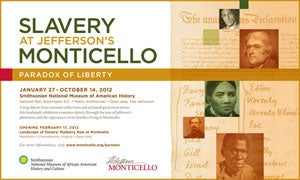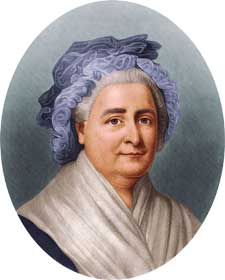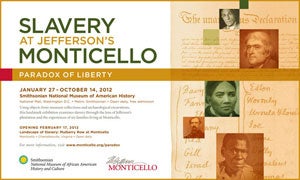KINGSTON, R.I. –January 12, 2012–-Thomas Jefferson, author of the Declaration of Independence and third president, called slavery “an abominable crime.” Yet in a typical year, he owned about 200 slaves.
 The Smithsonian’s National Museum of African American History and Culture will give visitors a glimpse of the Jefferson family and the six slave families living at his plantation when its exhibition of artifacts, “Slavery at Jefferson’s Monticello: Paradox of Liberty,” opens later this month.
The Smithsonian’s National Museum of African American History and Culture will give visitors a glimpse of the Jefferson family and the six slave families living at his plantation when its exhibition of artifacts, “Slavery at Jefferson’s Monticello: Paradox of Liberty,” opens later this month.
“Eight of the first 12 presidents owned slaves,” says Marie Jenkins Schwartz, professor of history at the University of Rhode Island, who wrote two books about slavery and is working on a third, Slaveholders All!: The Washington, Jefferson, and Madison Women. All three Virginia families had large slave holdings.
While historians tend to look at the presidents, very few focus on their wives, daughters, granddaughters and other female relatives. Yet these women, argues Schwartz, maintained daily interactions with slaves throughout their lives.
“We don’t have a complete picture of slavery without learning their stories, yet finding documentary evidence is like finding a needle in a haystack,” says Schwartz. “Slavery is not what people wanted to be remembered for or what Americans wanted to remember about their Presidents, so much of that story has been written out of history and not acknowledged. Only recently have historians begun to take a closer look and I’m part of that trend.”
 Martha Washington.
Martha Washington.
Before Martha Washington married our first president, she was married to Daniel Parke Custis, a large slaveholder and heir to one of Virginia’s largest fortunes. The couple had four children, but only one survived beyond infancy. When Custis died, his widow inherited the use of his slaves. After she married George, he managed the Custis estate and the estate slaves in addition to his own. While the couple had no children, they raised two of Martha’s children and later two of Martha’s grandchildren as their own. They also provided personal and financial help to nieces, and nephews. Martha relied on slaves daily and raised her children in expectation that they would do the same. She even brought slaves with her when she traveled to Valley Forge to be with her husband during the winter encampment.
At his death, Washington oversaw 326 slaves. He stipulated in his will that his slaves be emancipated after Martha’s death. Martha, however, emancipated them within a year. (Interestingly Martha made no effort to free the one slave she owned outright at her death.)
Since the Custis slaves and the Washington slaves lived together for decades, there were close-knit families that were pulled apart when the Washington slaves were emancipated.
Washington did not, and could not, emancipate the Custis slaves as they belonged to Custis descendents.
Martha Jefferson
Thomas Jefferson married widow Martha Wayles Skelton who died in her 30s. Jefferson never remarried. The couple had five children. Two girls survived to adulthood. One of them died in her 20s. The surviving daughter, also named Martha, married Thomas Mann Randolph Jr. and raised a large family.
Much has been written about Jefferson’s relationship with his slave Sally Hemings, his wife’s half sister with whom, most historians agree, he had at least one child. “After Jefferson’s death, his daughter let Sally go, which is not the same as freeing her and giving her the necessary papers,” Schwartz notes.
Jefferson freely spent money and eventually overspent his income. At the end of his life, most of his slaves were sold to pay his debts.
“There was always a fear among slaves that when an owner died the estate might be divided and slave family members would be separated,” says Schwartz.
 Dolley Madison
Dolley Madison
Dolley Madison grew up in a slave-holding household in Virginia. However, by the time she was a teenager, her Quaker father grew increasingly anti-slavery, freed his slaves, and moved the family to Philadelphia. There, Dolley married John Todd, a lawyer, who didn’t own slaves. The couple had two children. When her husband and youngest son died, Dolley married James Madison who had 100 slaves at the time. The future president took his bride and her surviving son to live at Montpelier, the Madison family home in Virginia. The Madisons did not have children, but they took in one of Dolley’s young sisters and raised her as part of the family along with Dolley’s surviving son Payne. Like Jefferson, Madison had a hard time living within his means, and in the end slaves were sold to pay for his and Dolley’s lavish lifestyle. Payne inherited a few slaves, which he eventually freed. Other family members, however, including Dolley and her niece did not free the slaves they inherited.
Society and Slavery
“There is a tendency to say that everyone had slaves and our founding fathers were just part of society at that time,” says Schwartz. “But there was not just one idea about slavery among the population. There were people who opposed slavery and people who chose not to be slaveholders.
“I often hear that the first families were good slaveholders. I’m not sure what that means. As an historian, I look for specific citings for proof, but don’t find them,” the professor adds. “There seems to be a need in this country to believe our founders were upstanding moral people and in many ways they were. But you have to look at the ethics of holding people in bondage. The founders did not break the law. Slavery was legal. My book will be a personal story about the Washington, Jefferson, and Madison women and their slaves, but it will also be about a history of our nation.”
Note to Editors: There is a painting of the Jefferson’s daughter Martha Jefferson Randolph by Thomas Sully. However, no photo or image of Jefferson’s wife, Martha Wayles Jefferson appears to exist.

